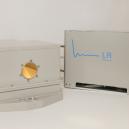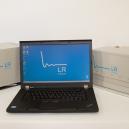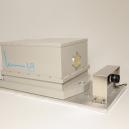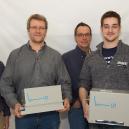LR has developed a new Fourier transform spectrometer (FTS) for airborne applications. Our new compact airborne spectro-radiometer is a small and lightweight FTS based on a two-port optical design. It uses a Stirling-cooled detector encompassing MCT (650 – 1875 cm-1) and InSb (1750 – 5745 cm-1) sensors allowing a broad spectral coverage (15.4 – 1.75 mm). The full field of view (FOV) of the instrument (FWHM) is adjustable between 10 - 50 mrad. At maximum FOV, the maximum spectral resolution is 0.8 cm-1. Spectral calibration is achieved with a DFB semiconductor laser beam emitting at 1550 nm.
Scanning of the optical path difference (OPD) is achieved by two mutually perpendicular corner cube mirrors swinging about a common pivot point. Beam splitting and OPD compensation are achieved using potassium bromide (KBr) splitting and compensating plates accepting a 25.4-mm diameter beam.
Three signal sampling rates are available (32, 50 and 150 kHz). At the highest sampling rate and at a spectral resolution of 16 cm-1, the instrument acquires 72 interferograms per second. At maximum FOV, 16 cm-1 resolution and one-second acquisition time, the noise-equivalent spectral radiances (NESR) of the instrument are respectively 1.1 x 10-11 and 1.6 x 10-11 W/cm2/sr/cm-1 for the MCT and InSb sensors. The sensors’ radiometric accuracies are 2.1 % (MCT) and 3.0 % (InSb), while their radiometric stabilities (2s, 12 hours) are 2.0 % (MCT) and 2.4 % (InSb).
The optical head of this instrument measures only 19 x 24 x 34 cm3. The electronic box (E-Box) measures 24 x 31 x 23 cm3.
The instrument can be operated by an operator using a laptop running the Edgar software, or can be operated by the pilot using our compact pilot interface. The instrument can store data internally, that can be retrieved later for post processing and data analysis.




